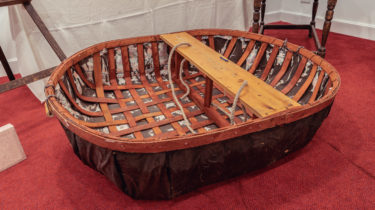
Journeys in Design is keen to draw on the locality interest in The Currach Project established during Our Linen Stories Tour in 2019.
The Currach is an ancient boat form common to Scotland, Ireland, Wales and other cultures worldwide. The Spey Currach was used by loggers along Scotland’s fastest flowing river. This proposal teams up colleagues and communities across Badenoch and Strathspey to co-design and produce a brand new Currach for Scotland using Flax Fibre bio composite.
A Call to Currach
- A Highland heritage updated
- Material Innovation and Co-Design
- Creative fellowship and community
Exploring the potential of a collaborative design project facilitated by Grantown on Spey Museum and engaging communities in the Badenoch and Strathspey region to create a new Currach for Scotland
Journeys in Design has been exploring the rich material culture of flax fibre and linen in Scotland, including the development of material science around flax fibre: as glass fibre is to fibreglass, so flax fibre is to flax fibre bio-composite, conferring strength and some flexibility. Flax fibre bio-composite is a more ecological material. Our Linen Stories core exhibition includes Scottish-designed and manufactured flax skis.
The Currach is traditionally made from an animal hide stretched over a wooden lattice. The boat form varies in use on different waterways and is often named after the associated river. The Spey Currach is a round basket form and was used by loggers transporting rafts of cargo towards the busy eighteenth- and nineteenth-century North Sea ports: this work is beautifully enlivened by displays in the Grantown Museum. A surviving nineteenth century Spey Currach is on display at Elgin Museum.
Current interest in this boat form in Ireland and Wales is buoyant with local Curragh Clubs on the Boyne for example and an active Coracle Society in Wales. There is long standing interest in the power of community boat building in Scotland including the GalGael project in Glasgow, the Portsoy Traditional Boat Festival and at the Boat Building School at the Scottish Maritime Museum Irvine.
Journeys in Design ventured to The Highland Folk Museum in Newtonmore with Our Linen Stories in October 2018 and was introduced to the boats created locally by Raymond, a Welshman living in nearby Insh, a man with a passion for coracles. Raymond has volunteered for some years at the museum, creating the round baskets and supporting their use as pleasure boats on the museum pond during the summer months.
With financial support from the Coracle Society, Highland Folk Museum took delivery of three fibreglass coracles which now see active service out from a eco-boatshed built by Raymond and his troupe of Museum volunteers.
Journeys in Design returned to the Highlands in May 2019, to Grantown-on-Spey, one of the planned eighteenth-century Highland Linen Newtowns. In the town museum, we displayed one of the fibreglass Currachs on loan from the Highland Folk Museum. On 18 May 2019, International Museums Day, we set out our proposal, to create a new Currach by community co-design using flax fibre bio-composite
We seek to explore the generative potential of this proposal for Grantown Museum and its community and more widely in the Badenoch and Strathspey region of the Highlands, noting potential outcomes:
- Community engagement
- Education across multiple levels
- Employment opportunities in the development phase
- Income generation for engaged Organisations
- Sustainable Production of a new Currach for Scotland
Learn more about the context of the Currach Project in this video.
Bruce Clark, author, journalist and committed cultural historian in conversation with Our Linen Stories curator John Ennis. The pair discuss early Christianity, long standing trade routes and popular pleasure sailing today, as well as the Currach Project itself.

